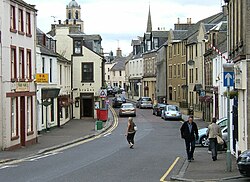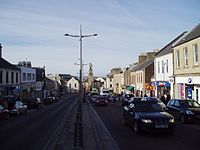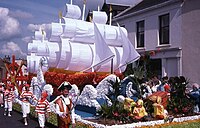Lanark
| Lanark | |
| Lanarkshire | |
|---|---|
 Lanark | |
| Location | |
| Grid reference: | NS8843 |
| Location: | 55°40’30"N, 3°46’37"W |
| Data | |
| Population: | 8,255 (2001) |
| Post town: | Lanark |
| Postcode: | ML11 |
| Dialling code: | 01555 66 |
| Local Government | |
| Council: | South Lanarkshire |
| Parliamentary constituency: |
Lanark and Hamilton East |
Lanark is a small town and royal burgh in Lanarkshire, of which it is the county town. It stands above the River Clyde in Clydesdale, a steep bank dropping down to the river.
Lanark, though full of history and pleasing townscapes, has little industry and is becoming a commuter town for Glasgow and Edinburgh. Its shops serve the local agricultural community and surrounding villages. There is a large, modern livestock auction market on the outskirts of the town.
The town's name is in origin from the ancient British or Old Welsh language, Lanerc meaning "clear space or glade", comparable to the Welsh Llanerch.[1]
Churches
- Church of Scotland:
- St Nicolas, the parish church. This stands at the bottom of the high street. The church bell is believed to date from 1110, and may be one of the oldest church bells in the world.
- Greyfriars Parish Church
- Kirkmuirhill Church
- The Old Church of St Kentigern: now abandoned. The town's cemetery stands on the site and includes many Covenanter graves.
- Scottish Episcopal Church: Christ Church
History

Lanark has served as an important market town since mediæval times, and King David I made it a Royal Burgh in 1140, giving it certain mercantile privileges relating to government and taxation. King David I realised that greater prosperity could result from encouraging trade. Lanark thus formed one of the King's new burghs spread across Scotland to be centres of up to date civic culture in a country largely still rural and rooted in ancient ways. The new burghs were established so as to encourage the development of trade within their area, each laid out with a market place and so that each merchant who came to the town would be granted a plot of land, a feu or rig, bordering on the marketplace. The layout of the feus in Lanark can still be easily seen between the north side of Lanark High Street (the former market place) and North Vennel, a lane which runs behind the feus. A motte and bailey castle was also constructed at the bottom of Castlegate.
William Wallace "first drew sword to free his native land" in Lanark in May 1297, when he killed the English sheriff, Haselrig, for reasons never explained. According to tradition his house stood in Castlegate, next to what is now the Clydesdale Bank, where a plaque commemorates his exploits. A public house bears the name of the "Wallace Cave". Since 2005, the town has held a festival every August in Wallace's memory, which has grown into the largest history festival in Scotland.[2]
Landmarks
Visitors to the town can visit the nearby World Heritage Site of New Lanark, close to the Falls of Clyde, the Corehouse estate and the Scottish Wildlife Trust's Corehouse Nature Reserve.
The Lanark Museum is located in West Port.
A large boating lake, Lanark Loch, adjoins a golf course and the former racecourse, the latter offering pony-trekking activities.
The town's Castlebank Park lies near the former site of Lanark Castle, and allows access to the River Clyde and the Clyde Walkway.
An ornate gas lamp, known as the 'Provost's Lamp' stands at the bottom of the high street. The lamp used to be placed outside the home of whoever was Provost of Lanark at the time.
One of the churches in the town bears the name of The Old Church of St Kentigern (perhaps better known as St Mungo), who founded many churches in the Scottish Lowlands, including Glasgow, and who died about 612. St Kentigerns is one of the few remaining Scottish buildings of the 13th Century still standing. The town's cemetery stands on the site of The Old Church of St Kentigern, and includes many Covenanter graves.
The parish kirk, St Nicholas, stands at the bottom of the high street. It as built in 1774 since St Kentigern's had become ruinous. The church bell is believed to date from 1110, and may be one of the oldest church bells in the world and it has been recast four times, including 1659 and 1983. The bell was moved from The Old Church of St Kentigern when St Nicholas's Church was built. In the steeple of St Nicholas there is an 8-foot statue of William Wallace sculpted by Robert Forrest, from an ancient drawing in the possession of the Society of Antiquaries.
Lanark Lanimer Day

The Lanark Lanimer celebrations take place each year for one week in June, drawn deep from the town's historic traditions. Local primary schoolchildren elect a Lanimer Queen and court; and a Lord Cornet is chosen from local businessmen.
On the Monday night the Perambulation of the Marches takes place, when townspeople turn out to walk around half the town boundary, following the Lord Cornets past and present as they inspect the border-stones. Traditionally, the townspeople carry "birks", which are small branches of birch trees cut from the woods at the Glenburnie estate (this particular tradition was started in 1948 by Joseph Doolan, whose family owned the land). The other half of the boundary is inspected on the Wednesday night, again led by the Lord Cornet accompanied by many local riders who participate in the Riding of the Marches, locally referred to as the Rideout.
On the Thursday morning, schools and other organisations parade before the Lanimer Queen in themed dress, accompanied by pipe bands. The best floats win prizes, and after the parade the crowning of the Queen takes place on a temporary stand erected in front of St Nicholas's Church. The Lanimer Queen holds a reception party in the town's Memorial Hall on the Thursday and Friday nights, where children perform songs and dances.
Music
The Lanark & District Pipe Band has two units which compete in competitions run by the Royal Scottish Pipe Band Association - one competing in grade 4b and one in grade 3a, having been upgraded from 4b to 4a to 3b to 3a in consecutive years from 2004.
The 'Music in Lanark' programme began in 2000 with the aim of bringing a variety of the highest quality live music to the town. In the first five years there were three classical concerts, one jazz concert and one traditional music concert. The programme continues to grow.
References
- ↑ Scottish place names, W. F. H. Nicolaisen, p.164, 172, London, 1976
- ↑ Scotland's Festival of History
- Historical Tours in the Clyde Valley. Published by the Clyde Valley Tourist Association and the Lanark & District Archaeological Association. Printed by Robert MacLehose and Company Limited, Renfrew, Scotland. 1982.
- Building the Royal Burghs by John Barrett and David Iredale. Published in The Scots Magazine. Volume 142, Number 1. January 1995. pp 10 – 22.
- Upper Clydesdale - A History and Guide by Daniel Martin. Published by the Tuckwell Press, Phantassie, East Linton. 1999.
- Clydesdale District Guide. Published by Clydesdale District Guide. 1995.
- Lanark Heritage Trail. Published by South Lanarkshire Council. 2001.